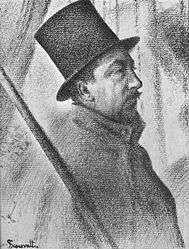Conté

Conté, also known as Conté sticks or Conté crayons, are a drawing medium composed of compressed powdered graphite or charcoal mixed with a wax or clay base, square in cross-section. They were invented in 1795 by Nicolas-Jacques Conté, who created the combination of clay and graphite in response to the shortage of graphite caused by the Napoleonic Wars (the British naval blockade of France prevented import). Conté crayons had the advantage of being cost-effective to produce, and easy to manufacture in controlled grades of hardness.
They are now manufactured using natural pigments (iron oxides, carbon black, titanium dioxide), clay (kaolin), and a binder (cellulose ether).[1]
Conté crayons are most commonly found in black, white, and sanguine tones, as well as bistre, shades of grey, and other colors. Currently in the USA, sets of 12 assorted portrait and landscape colors are available as well as a sketching set, plus sets of 18, 24 or 48 colors. In Europe, 22 more colors are available and the colors other than sanguine, bistre, grey, black, and white are available open stock.
Colors sets are especially useful for field studies and color studies. Some artists create entire paintings with them, using them more like pastels than like a drawing medium. They are also used often to sketch under pastel paintings or lay down initial layers before using dry pastels. The colors sets lean toward very bright spectrum hues that mix well; even the 12 assorted color set can be layered to produce any hues or values desired. Color Conté mixes better on paper than many hard pastel products.
They are frequently used on rough paper that holds pigment grains well. They can also be used on prepared primed canvases for underdrawing for a painting. The sticks' square profile make Conté crayons more suitable for detailed hatched work as opposed to the bolder painterly drawing style demanded by soft pastels.
Georges Seurat
In the 1880s, Georges Seurat used Conté crayons to produce many of his studies.
|
See also
References
- ↑ "Conte à Paris". Archived from the original on 2007-08-09.
External links
-
 Media related to Drawings by Georges Seurat at Wikimedia Commons
Media related to Drawings by Georges Seurat at Wikimedia Commons


